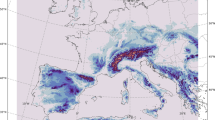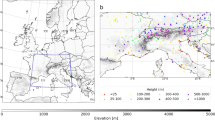Abstract
Ensemble numerical experiments with the climate model of intermediate complexity developed at the A.M. Obukhov Institute of Atmospheric Physics of the Russian Academy of Sciences (IAP RAS CM) are conducted to estimate the efficiency of controlled climate forcing (geoengineering) due to stratospheric sulfate aerosol (SSA) emissions in order to compensate for global warming under the SRES A1B anthropogenic emission scenario. Full (or even excessive) compensation for the expected anthropogenic warming in the model is possible with sufficiently intense geoengineering. For ensemble members with values of the governing parameters corresponding to those obtained for the Mt. Pinatubo eruption, global warming is reduced by no more than 0.46 K in the second half of the 21st century, with a residual rise in the global surface temperature T g comparative to 1961–1990 of 1.0–1.2 K by 2050 and 1.9–2.2 K by 2100. The largest reduction in global warming (with the other parameters of the numerical experiment being equal) is found not for a meridional distribution of SSA concentration peaked at low latitudes (despite the largest (in magnitude) global compensation instantaneous radiative forcing), but for a uniform horizontal aerosol distribution and for a distribution with the SSA concentration maximum in the middle and subpolar latitudes of the Northern Hemisphere. The efficiency of geoengineering in terms of T g in the second half of the 21st century between the most efficient and the least efficient meridional distributions of stratospheric aerosols differs by as much as one-third, depending on the values of other governing parameters. For meridional distributions of SSA concentration, which produce the largest deceleration of global warming, such a deceleration is regionally most pronounced over high- and subpolarlatitude land areas and in the Arctic. In particular, this is expressed in the smallest reduction in the sea-ice extent and permafrost area under climate warming in the model. The compensation forcing also decelerates a general increase in global annual precipitation P g during warming. The relative deceleration in precipitation increase is most pronounced in land regions outside the tropics, where a significant deficit in precipitation is currently observed. After the theoretical completion of geoengineering in the first or second decade, its temperature effect vanishes with an abrupt acceleration of global and regional surface warming. For individual members of the ensemble experiment, the global temperature change in this period is five times as large as that in the experiment without geoengineering and ten times as large regionally (in northeastern Siberia).
Similar content being viewed by others
References
Climate Change 2001: The Scientific Basis, Contribution of Working Group I to the Third Assessment Report of the Intergovernmental Panel on Climate Change, Ed. by J. T. Houghton, Y. Ding, D. J. Griggs, et al. (Cambridge Univ. Press, Cambridge, 2001).
I. I. Mokhov, A. V. Eliseev, P. F. Demchenko, et al., “Climate Changes and Their Estimation with the IAP RAS Global Model,” Dokl. Akad. Nauk 402, 243–247 (2005).
Climate Change 27: The Physical Science Basis, Ed. by S. Solomon, D. Qin, M. Manning, et al. (Cambridge Univ. Press, Cambridge, 2007).
M. I. Budyko, Climate Change (Gidrometeoizdat, Leningrad, 1974) [in Russian].
S. H. Schneider, “Geoengineering: Could—or Should—We Do It?,” Clim. Change 33, 291–302 (1996).
S. H. Schneider, “Earth Systems Engineering and Management,” Nature 409(6868), 417–421 (2001).
Yu. A. Izrael’, “Effective Way of Retaining Climate at the Present-Day Level Is the Main Goal of Solving the Climate Problem,” Meteorol. Gidrol., No. 10, 5–9 (2005).
P. J. Crutzen, “Albedo Enhancement by Stratospheric Sulfur Injections: a Contribution to Resolve a Policy Dilemma?,” Clim. Change 77, 211–219 (2006).
T. M. L. Wigley, “A Combined Mitigation/Geoengineering Approach to Climate Stabilization,” Science 314(5798), 452–454 (2006).
V. Brovkin, V. Petoukhov, M. Claussen, et al., “Geoengineering Climate by Stratospheric Sulfur Injections: Earth System Vulnerability to Technological Failure,” Clim. Change (in press).
P. J. Rasch, P. J. Crutzen, and D. B. Coleman, “Exploring the Geoengineering of Climate Using Stratospheric Sulfate Aerosols: the Role of Particle Size,” Geophys. Rev. Lett. 35, L02809 (2008).
K. E. Trenberth and A. Dai, “Effects of Mount Pinatubo Volcanic Eruption on the Hydrological Cycle as an Analog of Geoengineering,” Geophys. Rev. Lett. 34, L15702 (2007).
A. Robock, L. Oman, and G. L. Stenchikov, “Regional Climate Responses to Geoengineering with Tropical and Arctic SO2 Injections,” J. Geophys. Res. 113, D16101 (2008).
H. D. Matthews and K. Caldeira, “Transient Climate-Carbon Simulations of Planetary Geoengineering,” Proc. Natl. Acad. Sci. U.S.A. 104, 9949–9954 (2007).
S. Tilmes, R. Muller, and R. Salawitch, “The Sensitivity of Polar Ozone Depletion to Proposed Geoengineering Schemes,” Science 320(5880), 1201–1204 (2008).
V. K. Petoukhov, I. I. Mokhov, A. V. Eliseev, and V. A. Semenov, The IAP RAS Global Climate Model (Dialogue-MSU, Moscow, 1998).
I. I. Mokhov, A. V. Eliseev, and A. A. Karpenko, “Sensitivity of the IAP RAS Global Climate Model with an Interactive Carbon Cycle to Anthropogenic Forcings,” Dokl. Akad. Nauk 407, 400–404 (2006).
A. V. Eliseev, I. I. Mokhov, and A. A. Karpenko, “Climate and Carbon Cycle Variations in the 20th and 21st Centuries in a Model of Intermediate Complexity,” Izv. Akad. Nauk, Fiz. Atmos. Okeana 43, 3–17 (2007) [Izv., Atmos. Ocean. Phys. 43, 1–14 (2007)].
A. V. Eliseev, I. I. Mokhov, M. M. Arzhanov, et al., “Interaction of the Methane Cycle and Processes in Wetland Ecosystems in a Climate Model of Intermediate Complexity,” Izv. Akad. Nauk, Fiz. Atmos. Okeana 44, 147–162 (2008) [Izv., Atmos. Ocean. Phys. 44, 139–152 (2008)].
A. V. Eliseev and I. I. Mokhov, “Influence of Volcanic Activity on Climate Change in the Past Several Centuries: Assessments with a Climate Model of Intermediate Complexity,” Izv. Akad. Nauk, Fiz. Atmos. Okeana 44, 723–746 (2008) [Izv., Atmos. Ocean. Phys. 44, 671–683 (2008)].
I. I. Mokhov and A. V. Eliseev, “Geoengineering Efficiency: Preliminary Assessment with a Climate Model of Intermediate Complexity,” in Research Activities in Atmospheric and Oceanic Modelling., Ed. by J. Nöte (World Climate Research Programme, Geneva, 2008), pp. 07-21–07-22.
G. J. S. Bluth, S. D. Doiron, C. C. Schnetzler, et al., “Global Tracking of the SO2 Clouds from the June, 1991 Mount Pinatubo Eruptions,” Geophys. Rev. Lett. 19, 151–154 (1992).
J. Hansen, M. Sato, L. Nazarenko, et al., “Climate Forcings in Goddard Institute for Space Studies SI2000 Simulations,” J. Geophys. Res. 107, 4347 (2002).
K. Ya. Kondrat’ev, “From Nano- to Global Scales: Properties, Processes of Formation and Aftereffect of Atmospheric-Aerosol Actions: 7. Aerosol Radiative Disturbing Action and Climate,” Opt. Atmos. Okeana 18, 535–536 (2005) [Atmos. Ocean. Optics, 18, 177–188].
G. Marland, T. A. Boden, and R. J. Andres, “Global, Regional, and National CO2 Emissions,” in Trends: a Compendium of Data on Global Change (Oak Ridge Carbon Dioxide Information Analysis Center, Oak Ridge National Laboratory, U.S. Dept. of Energy, 2005).
R. A. Houghton, “Revised Estimates of the Annual Net Flux of Carbon to the Atmosphere from Changes in Land Use and Land Management 1850–2000,” Tellus B 55, 378–390 (2003).
D. I. Stern and R. K. Kaufmann, “Estimates of Global Anthropogenic Methane Emissions 1860–1993,” Chemosphere 33, 159–176 (1996).
M. C. MacFarling, D. Etheridge, C. Trudinger, et al. “Law Dome CO2, CH4 and N2O Ice Core Records Extended to 2000 Years BP,” Geophys. Res. Lett. 33, L14810 (2006).
L. W. Horowitz, “Past, Present, and Future Concentrations of Tropospheric Ozone and Aerosols: Methodology, Ozone Evaluation, and Sensitivity to Aerosol Wet Deposition,” J. Geophys. Res. 111, D22211 (2006).
A. Robock, “Volcanic Eruptions and Climate,” Rev. Geophys. 38, 191–219 (2000).
J. Hansen, A. Lacis, R. Ruedy, and M. Sato, “Potential Climate Impact of Mount Pinatubo Eruption,” Geophys. Rev. Lett. 19, 215–218 (1992).
J. E. Hansen and L. D. Travis, “Light Scattering in Planetary Atmospheres,” Space Sci. Rev. 16, 527–610 (1974).
O. Boucher, S. E. Schwartz, T. P. Ackerman, et al., “Intercomparison of Models Representing Direct Shortwave Radiative Forcing by Sulfate Aerosols,” J. Geophys. Res. D 103, 16 979–16 998 (1998).
G. L. Stenchikov, I. Kirchner, A. Robock, et al., “Radiative Forcing from the 1991 Mount Pinatubo Volcanic Eruption,” J. Geophys. Res. D 103, 13 837–13 857 (1998).
M. Claussen, L. Mysak, A. Weaver, et al., “Earth System Models of Intermediate Complexity: Closing the Gap in the Spectrum of Climate System Models,” Clim. Dyn. 18, 579–586 (2002).
V. Petoukhov, M. Claussen, A. Berger, et al., “EMIC Intercomparison Project (EMIP-CO2): Comparative Analysis of EMIC Simulations of Current Climate and Equilibrium and Transient Reponses to Atmospheric CO2 Doubling,” Clim. Dyn. 25, 363–385 (2005).
A. V. Eliseev, I. I. Mokhov, and A. A. Karpenko, “Influence of Direct Sulfate-Aerosol Radiative Forcing on the Results of Numerical Experiments with a Climate Model of Intermediate Complexity,” Izv. Akad. Nauk, Fiz. Atmos. Okeana 43, 591–601 (2007) [Izv., Atmos. Ocean. Phys. 43, 544–554 (2007)].
J. Hansen, M. Sato, and R. Ruedy, “Radiative Forcing and Climate Response,” J. Geophys. Res. D 102, 6831–6864 (1997).
G. J. Boer and B. Yu, “Climate Sensitivity and Response,” Clim. Dyn. 20, 415–429 (2003).
G. J. Boer and B. Yu, “Climate Sensitivity and Climate State,” Clim. Dyn. 21, 167–176 (2003).
J. Hansen, M. Sato, R. Ruedy, et al., “Efficacy of Climate Forcings,” J. Geophys. Res. 110, D18104 (2005).
J. R. Holton, P. H. Haynes, M. E. McIntyre, et al., “Stratosphere-Troposphere Exchange,” Rev. Geophys. 33, 403–439 (1995).
P. M. Cox, R. A. Betts, and C. D. Jones, et al., “Acceleration of Global Warming Due to Carbon-Cycle Feedbacks in a Coupled Climate Model,” Nature 408, 184–187 (2000).
P. Friedlingstein, L. Bopp, P. Ciais, et al., “Positive Feedback between Future Climate Change and the Carbon Cycle,” Geophys. Rev. Lett. 28, 1543–1546 (2001).
P. Friedlingstein, P. Cox, R. Betts, et al., “Climate-Carbon Cycle Feedback Analysis: Results from the C4MIP Model Intercomparison,” J. Clim. 19, 3337–3353 (2006).
P. Brohan, J. J. Kennedy, I. Harris, et al., “Uncertainty Estimates in Regional and Global Observed Temperature Changes: a New Data Set from 1850,” J. Geophys. Res. 111, D12106 (2006).
Author information
Authors and Affiliations
Corresponding author
Additional information
Original Russian Text © A.V. Eliseev, I.I. Mokhov, 2009, published in Izvestiya AN. Fizika Atmosfery i Okeana, 2009, Vol. 45, No. 2, pp. 232–244.
Rights and permissions
About this article
Cite this article
Eliseev, A.V., Mokhov, I.I. Estimating the efficiency of mitigating and preventing global warming with scenarios of controlled aerosol emissions into the stratosphere. Izv. Atmos. Ocean. Phys. 45, 221–232 (2009). https://doi.org/10.1134/S0001433809020078
Received:
Accepted:
Published:
Issue Date:
DOI: https://doi.org/10.1134/S0001433809020078




